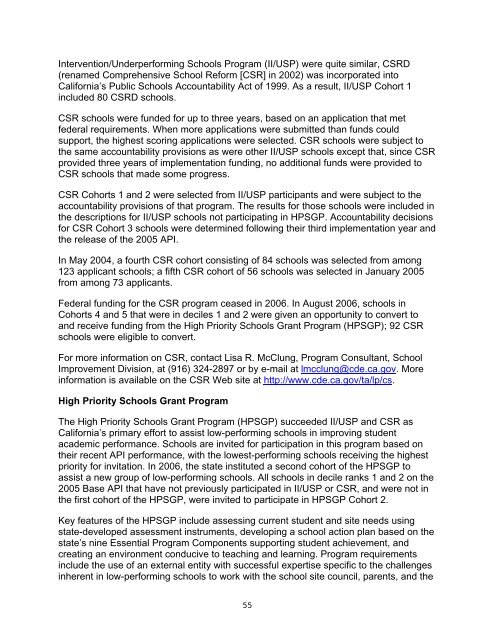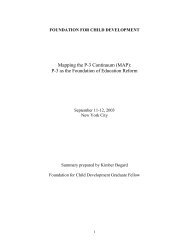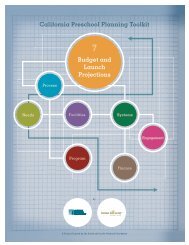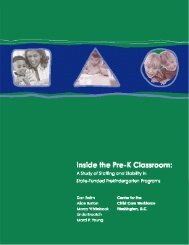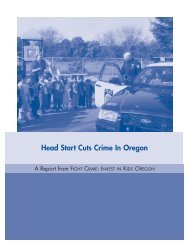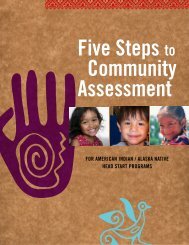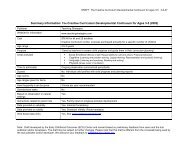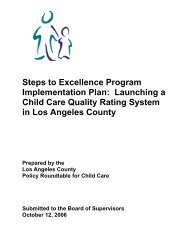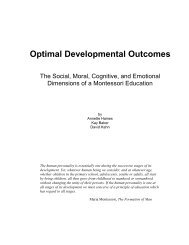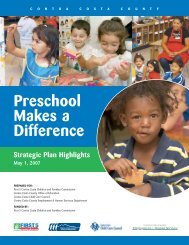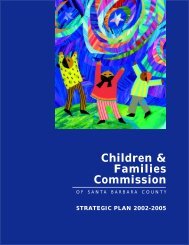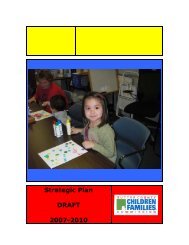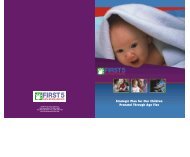Download this file - Plan4Preschool
Download this file - Plan4Preschool
Download this file - Plan4Preschool
You also want an ePaper? Increase the reach of your titles
YUMPU automatically turns print PDFs into web optimized ePapers that Google loves.
Intervention/Underperforming Schools Program (II/USP) were quite similar, CSRD<br />
(renamed Comprehensive School Reform [CSR] in 2002) was incorporated into<br />
California’s Public Schools Accountability Act of 1999. As a result, II/USP Cohort 1<br />
included 80 CSRD schools.<br />
CSR schools were funded for up to three years, based on an application that met<br />
federal requirements. When more applications were submitted than funds could<br />
support, the highest scoring applications were selected. CSR schools were subject to<br />
the same accountability provisions as were other II/USP schools except that, since CSR<br />
provided three years of implementation funding, no additional funds were provided to<br />
CSR schools that made some progress.<br />
CSR Cohorts 1 and 2 were selected from II/USP participants and were subject to the<br />
accountability provisions of that program. The results for those schools were included in<br />
the descriptions for II/USP schools not participating in HPSGP. Accountability decisions<br />
for CSR Cohort 3 schools were determined following their third implementation year and<br />
the release of the 2005 API.<br />
In May 2004, a fourth CSR cohort consisting of 84 schools was selected from among<br />
123 applicant schools; a fifth CSR cohort of 56 schools was selected in January 2005<br />
from among 73 applicants.<br />
Federal funding for the CSR program ceased in 2006. In August 2006, schools in<br />
Cohorts 4 and 5 that were in deciles 1 and 2 were given an opportunity to convert to<br />
and receive funding from the High Priority Schools Grant Program (HPSGP); 92 CSR<br />
schools were eligible to convert.<br />
For more information on CSR, contact Lisa R. McClung, Program Consultant, School<br />
Improvement Division, at (916) 324-2897 or by e-mail at lmcclung@cde.ca.gov. More<br />
information is available on the CSR Web site at http://www.cde.ca.gov/ta/lp/cs.<br />
High Priority Schools Grant Program<br />
The High Priority Schools Grant Program (HPSGP) succeeded II/USP and CSR as<br />
California’s primary effort to assist low-performing schools in improving student<br />
academic performance. Schools are invited for participation in <strong>this</strong> program based on<br />
their recent API performance, with the lowest-performing schools receiving the highest<br />
priority for invitation. In 2006, the state instituted a second cohort of the HPSGP to<br />
assist a new group of low-performing schools. All schools in decile ranks 1 and 2 on the<br />
2005 Base API that have not previously participated in II/USP or CSR, and were not in<br />
the first cohort of the HPSGP, were invited to participate in HPSGP Cohort 2.<br />
Key features of the HPSGP include assessing current student and site needs using<br />
state-developed assessment instruments, developing a school action plan based on the<br />
state’s nine Essential Program Components supporting student achievement, and<br />
creating an environment conducive to teaching and learning. Program requirements<br />
include the use of an external entity with successful expertise specific to the challenges<br />
inherent in low-performing schools to work with the school site council, parents, and the<br />
55


